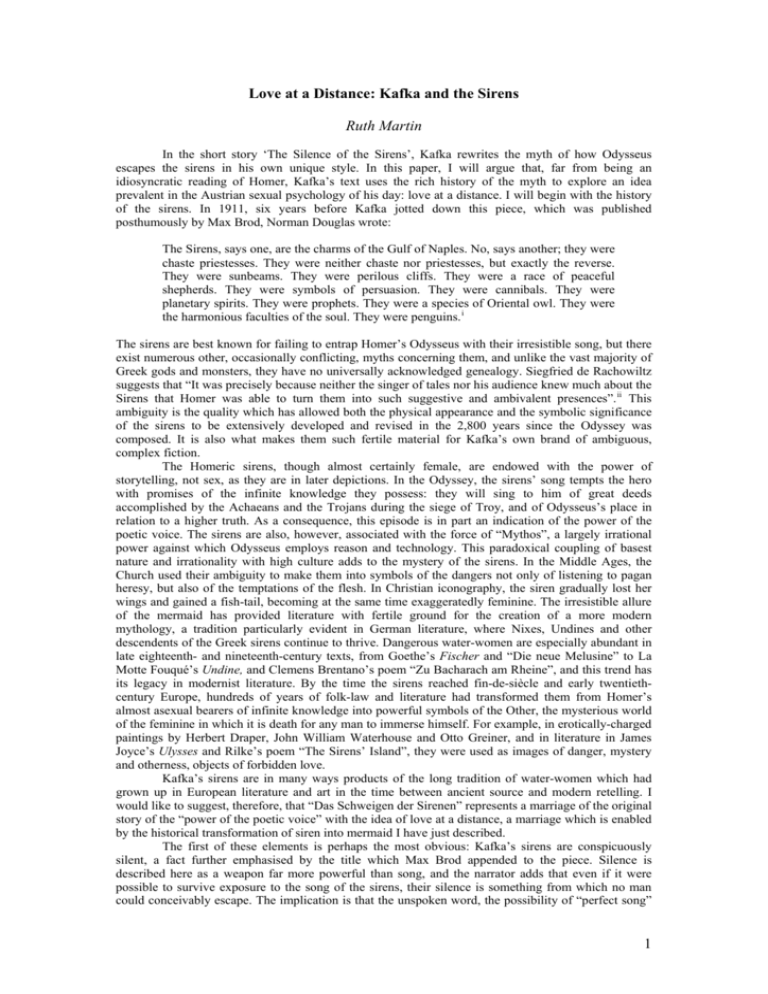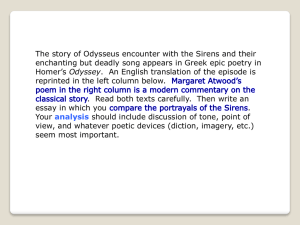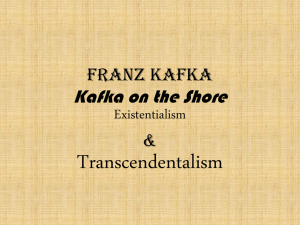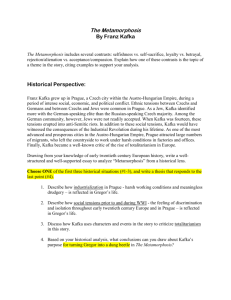
Love at a Distance: Kafka and the Sirens
Ruth Martin
In the short story ‘The Silence of the Sirens’, Kafka rewrites the myth of how Odysseus
escapes the sirens in his own unique style. In this paper, I will argue that, far from being an
idiosyncratic reading of Homer, Kafka’s text uses the rich history of the myth to explore an idea
prevalent in the Austrian sexual psychology of his day: love at a distance. I will begin with the history
of the sirens. In 1911, six years before Kafka jotted down this piece, which was published
posthumously by Max Brod, Norman Douglas wrote:
The Sirens, says one, are the charms of the Gulf of Naples. No, says another; they were
chaste priestesses. They were neither chaste nor priestesses, but exactly the reverse.
They were sunbeams. They were perilous cliffs. They were a race of peaceful
shepherds. They were symbols of persuasion. They were cannibals. They were
planetary spirits. They were prophets. They were a species of Oriental owl. They were
the harmonious faculties of the soul. They were penguins. i
The sirens are best known for failing to entrap Homer’s Odysseus with their irresistible song, but there
exist numerous other, occasionally conflicting, myths concerning them, and unlike the vast majority of
Greek gods and monsters, they have no universally acknowledged genealogy. Siegfried de Rachowiltz
suggests that “It was precisely because neither the singer of tales nor his audience knew much about the
Sirens that Homer was able to turn them into such suggestive and ambivalent presences”. ii This
ambiguity is the quality which has allowed both the physical appearance and the symbolic significance
of the sirens to be extensively developed and revised in the 2,800 years since the Odyssey was
composed. It is also what makes them such fertile material for Kafka’s own brand of ambiguous,
complex fiction.
The Homeric sirens, though almost certainly female, are endowed with the power of
storytelling, not sex, as they are in later depictions. In the Odyssey, the sirens’ song tempts the hero
with promises of the infinite knowledge they possess: they will sing to him of great deeds
accomplished by the Achaeans and the Trojans during the siege of Troy, and of Odysseus’s place in
relation to a higher truth. As a consequence, this episode is in part an indication of the power of the
poetic voice. The sirens are also, however, associated with the force of “Mythos”, a largely irrational
power against which Odysseus employs reason and technology. This paradoxical coupling of basest
nature and irrationality with high culture adds to the mystery of the sirens. In the Middle Ages, the
Church used their ambiguity to make them into symbols of the dangers not only of listening to pagan
heresy, but also of the temptations of the flesh. In Christian iconography, the siren gradually lost her
wings and gained a fish-tail, becoming at the same time exaggeratedly feminine. The irresistible allure
of the mermaid has provided literature with fertile ground for the creation of a more modern
mythology, a tradition particularly evident in German literature, where Nixes, Undines and other
descendents of the Greek sirens continue to thrive. Dangerous water-women are especially abundant in
late eighteenth- and nineteenth-century texts, from Goethe’s Fischer and “Die neue Melusine” to La
Motte Fouqué’s Undine, and Clemens Brentano’s poem “Zu Bacharach am Rheine”, and this trend has
its legacy in modernist literature. By the time the sirens reached fin-de-siècle and early twentiethcentury Europe, hundreds of years of folk-law and literature had transformed them from Homer’s
almost asexual bearers of infinite knowledge into powerful symbols of the Other, the mysterious world
of the feminine in which it is death for any man to immerse himself. For example, in erotically-charged
paintings by Herbert Draper, John William Waterhouse and Otto Greiner, and in literature in James
Joyce’s Ulysses and Rilke’s poem “The Sirens’ Island”, they were used as images of danger, mystery
and otherness, objects of forbidden love.
Kafka’s sirens are in many ways products of the long tradition of water-women which had
grown up in European literature and art in the time between ancient source and modern retelling. I
would like to suggest, therefore, that “Das Schweigen der Sirenen” represents a marriage of the original
story of the “power of the poetic voice” with the idea of love at a distance, a marriage which is enabled
by the historical transformation of siren into mermaid I have just described.
The first of these elements is perhaps the most obvious: Kafka’s sirens are conspicuously
silent, a fact further emphasised by the title which Max Brod appended to the piece. Silence is
described here as a weapon far more powerful than song, and the narrator adds that even if it were
possible to survive exposure to the song of the sirens, their silence is something from which no man
could conceivably escape. The implication is that the unspoken word, the possibility of “perfect song”
1
is far more enticing than the reality of the sirens’ voices could ever be; it is the passing sailor’s own
imagination which then torments and seduces him, and persuades him to leave his ship so that he may
at last experience this perfect song. Odysseus, with his ears full of wax (another quite fundamental
change made by Kafka to the original) is not subject to this torment: the story’s third paragraph
suggests that he escapes the sirens’ silence because he does not hear it. He construes their gestures as
belonging to a song that they are actually singing, and is therefore unaware of their more powerful
weapon. A further complication comes at the end of the story, in a codicil which puts forward the
possibility that Odysseus, so cunning that even the gods cannot see into his heart, may really have
heard the silence of the sirens and merely pretended the naïveté which saved him. The possible
interpretations of the sirens’ silence have dominated criticism of Kafka’s story, to the extent that it
seems superfluous to add another here. iii I mention it only because this idea of the “perfect song” is also
relevant to my main theme; this will become clear later.
The part of the story I really want to focus on is the second half, beginning half-way through
the third paragraph. As Odysseus’ ship passes the sirens’ island, he ceases to be aware of them, as he
“fixe[s] his gaze on the distance”. This far-sightedness is usually a characteristic attributed to the sirens
themselves, their muse-like omniscience precluding knowledge of the present moment, and yet Kafka
attributes it to Odysseus. A further complication comes in the next paragraph as, having passed from
the gaze of Odysseus, the sirens forget their desire to seduce and think only of keeping the hero in their
vision: “all that they wanted was to hold as long as they could the radiance that fell from Ulysses' great
eyes.” Although the sirens are acknowledged to be powerful, and indeed inescapable by all but
Odysseus, as soon as he has escaped them there occurs a strange reversal of power-relations whereby
the sirens are themselves seduced and left to languish on their rock. As the narrator points out, their
annihilation following this episode is avoided only by their lack of consciousness. With this parting
shot, Kafka deprives his sirens of every sort of power, including the power to destroy themselves.
This strange sequence of events is difficult to interpret without looking outside the story, and I
believe that it is intimately related to certain ideas on gender and sexuality which informed the Zeitgeist
of Kafka’s age, most notably those which appear in Otto Weininger’s book Sex and Character.
Jacques Le Rider suggests that Viennese modernism should be understood in terms of a triangle of
sexuality, Jewishness and questions of identity, iv and Sex and Character considers all three. It was
admired by a surprising number of German and Austrian intellectuals, amongst whom were Karl Kraus,
Ludwig Wittgenstein, Robert Musil, Arnold Schönberg, Georg Trakl, and Franz Kafka. The book was
published in 1903, as sexual psychology was becoming a widely-recognised discipline, and by 1925 its
popularity had occasioned twenty-five reprints. To modern eyes its ideas seem outrageously
misogynistic, but the work is a serious attempt, as David Luft points out, “to map every significant
human problem on the polarities of gender”. v I do not wish to suggest that “The Silence of the Sirens”
was directly influenced by Weininger: there is nothing in Kafka’s diaries or letters to suggest that this
is the case. I will argue instead that in this story, Kafka plays with the same ideas of femininity and
desire expressed in Sex and Character, a book with which his contemporaries and first readers would
also have been familiar. I shall take the second part of the story, as described above, point by point in
relation to Weininger.
1.
The Distant Gaze of Odysseus
As he approaches the sirens, but whilst he is still some way off, Odysseus studies them avidly in an
attempt to interpret their gestures. When he comes closer, he simply does not see them any more.
According to Weininger, “Sexual attraction increases with physical proximity; love is strongest in the
absence of the loved one; it needs separation, a certain distance, to preserve it.” vi Weininger separates
love from physical desire to the extent that their objects are conceived as two different types of women,
the one desired being an ordinary, imperfect human being, the one loved an “ideally beautiful”,
“immaculate” woman, an idea, in other words, projected by the lover onto the beloved. Proximity to the
object would entail the recognition of the “base femininity” within her, and so love, or more
specifically, platonic love, can take place only at a distance. Women, says Weininger, have no capacity
for this sort of feeling; love is strictly a masculine emotion. This, of course, is a corruption of the
tradition of what is now referred to as “courtly love”, “courtly” because the idea originates in a
medieval aristocratic milieu. The poet, the lover, falls for an inaccessible lady, perhaps married or of
royal blood. The lover is ennobled by his continual striving to attain the beloved through endless praise
and worship. Although the beloved is assumed to be worthy of such treatment, what ennobles the lover
is not the object of his devotion but the devotion itself, the service of an ideal. Similarly, in Kafka’s
story the wax in Odysseus’ ears means that the sirens’ song is only a projection of the hero’s own ideas
of the perfect song, and in order to maintain the beauty of this idea, he doesn’t allow himself to come
too close to it. The idea of Distanzliebe is not exactly new – a version of it appears in Goethe’s lovelorn
2
hero, young Werther – and Kafka is certainly not the first to use the image of the sirens to express it.
Weininger himself compares woman to “the soulless Undine” (p.188).
By way of a brief excursus: this idea of the projection of a male ideal of femininity onto a
love-object also prefigures one of the principle concepts of Jungian psychology. Jung argues that the
unconscious is home to everything that is felt to be “not-I”: in males, therefore, feminine qualities are
relegated to the unconscious, and appear as what Jung calls the ‘anima’. In the anima, repressed
feminine qualities form a female character, the anima-image, which is usually projected onto women.
When a man falls in love, he does not always fall in love with a woman, but with his own anima-image
unconsciously projected onto his chosen mate. vii Neither Jung nor Weininger are particularly popular
amongst literary theorists today, particularly among female academics, and it is not difficult to see why.
It is my belief that this is probably the reason for this quite striking aspect of Kafka’s story having been
overlooked in previous interpretations.
Kafka famously had a predilection for Distanzliebe in his own life, where the myth of the
sirens provides a model for his personal relationships. A quote from a letter to the doctor Robert
Klopstock demonstrates this perfectly:
...it’s the seductive voices of the night, the sirens sang that way too. One does them
an injustice if one believes that they set out to seduce; they knew that they possessed
claws and not fertile wombs, about which they complained loudly. They couldn’t
help the fact that their complaints sounded so beautiful.
In this passage, the sirens appear as an analogy for ‘the girl’s letter’ which has been tormenting him.
Kafka conducted his relationships with women almost entirely through long, frequent letters, in which
he urged intimacy but shied away from physical proximity. The sirens’ lack of a fertile womb, though
their song is highly seductive, is suggestive of the terrible conflict Kafka felt between the desire to
marry and have children, and the knowledge that this was impossible due to the devastating effect he
believed it would have on his work. The siren-song of the physical world, promising happiness and
fulfilment, is a song Kafka knows to be empty because he believes that domestic life would drain his
potency as an author.
2.
‘Sexual attraction increases with physical proximity’
To return to the text: women, says Weininger, are purely sexual creatures, ‘possessed by’ their sexual
organs and incapable of the higher idea of love. Kafka’s sirens illustrate this: as Odysseus approaches,
they are overcome by desire and forget their traditional purpose. They are also typical of Weiningerian
femininity in other ways: they wish only to retain “the radiance that fell from Ulysses’ great eyes”, in
which, presumably, they see their own reflections. Weininger’s remark that woman “can only value
herself at the rate of the man who has fixed his choice on her” suggests that women need to see
themselves reflected in men before they can have a sense of self-worth, and ultimately of self. This
brings me to the last point, the sirens’ lack of consciousness. “If the Sirens had possessed
consciousness they would have been annihilated at that moment. But they remained as they had been;
all that had happened was that Ulysses had escaped them.” Weininger puts forward the idea that
women lack an ego, since they have no continuous memory, no narrative sense of self, and no grasp of
cause and consequence. Kafka’s all-powerful sirens might have been expected to commit suicide
having been defeated, as they do in the Argonautica (when Jason escapes them), but since Kafka’s
sirens have no consciousness, no sense of cause and effect, they merely remain.
3.
Cultural Analogies and the Dialectics of Love
When I introduced Weininger, I said that Sex and Character had a larger aim: “to map every significant
human problem on the polarities of gender” (David Luft). This is true not only of Weininger, but of a
whole generation of Austrian writers and thinkers. Edward Timms tells us: “In turn-of-the-century
Vienna sexuality became the ‘symbolic territory’ where the fundamental issues of the age were
debated: the crisis of individual identity, the conflicts between reason and irrationalism, between
domination and subservience.” viii Max Brod, a member of this generation, writing in 1966, uses the
“symbolic territory” of sexuality to discuss the possibilities for a harmonious relationship between Jews
and Germans: “I call the central concept ‘Distanzliebe’. It does not only hold between Germans and
Jews, but wherever two populations with their own characters collide physically and spiritually.”
Whilst this hinders too great an intimacy,
3
…at the same time it creates, even out of the feeling of distance, the wish to bridge
the gap. Love at a distance is therefore a dialectical concept. In general, at least in
theory, where love is there can be no distance – and where there is distance, no love.
In this, Brod gives us the answer to why the story of Odysseus and the sirens provides such a good
paradigm for the idea of Distanzliebe: the movement of the ship as it passes the sirens’ island means
that a static relationship is never established. The connection is always in motion, always uncertain.
“The Silence of the Sirens” reflects this, as the perspective of both parties changes over the course of
the story, and the reader is left in a state of confusion about what has actually taken place. Adorno and
Horkheimer were to take up the image of Odysseus and the sirens in their Dialectic of Enlightenment,
as an example of the entanglement of myth and rationalism. ix Although Odysseus is often seen as a
Homeric ambassador of human rationalism in a world of threateningly mythical creatures, his death at
the hands of the sirens is prevented only by the advice of a witch who turns men into pigs. The
interaction between rational and irrational, culture and nature, is not always simple. The dialectic,
however, is a form of argument that moves towards the reconciliation of differences, and in the case of
Distanzliebe, this is a reconciliation which can never be achieved. Love at a distance is a paradox
which cannot be resolved. And this is what Kafka demonstrates so well in his story: there is progress
and development – Odysseus sails past the sirens – but, thanks to the confusion caused by the codicil,
no closure. There is no conclusion to the love relationship in Weininger either: its success depends on
the exact maintenance of an impossible state of tension between lover and beloved, a distance which
cannot be bridged but must not become too great lest the lover lose sight of his object. Kafka sets this
unrealistically static idea vividly in motion, showing the movement of the see-saw as the balance of
power shifts and struggles to maintain its equilibrium.
Kafka’s story belongs very much to the age in which he lived. Its single image, of Odysseus
passing by the silent sirens, addresses the issues Edward Timms highlights: rationalism versus
irrationalism, a useful legacy of the Homeric original, and dominance and subservience, all in terms of
sexuality and desire. But the story does not simply express the spirit of the times: by using this image,
Kafka places these modern concerns in the context of the cultural history of the Western world, and he
also moves Weininger’s theory on apace, bringing to light the dialectical aspect of Distanzliebe later
highlighted by Max Brod.
Notes
i
Norman Douglas, Siren Land (London: Martin Secker Ltd, 1911), p.26
Siegfried De Rachowiltz, De Sirenibus: An Inquiry into Sirens from Homer to Shakespeare (New
York and London, 1987), p.3
iii
Interpretations of the sirens’ silence have been given by, amongst others, Elizabeth Boa in her article
“Revoicing Silenced Sirens: A Changing Motif in Works by Franz Kafka, Frank Wedekind and
Barbara Köhler” in German Life and Letters. 57: Part 1, January 2004; Stéphane Moses, “Franz Kafka:
The Silence of the Sirens” in University of Denver Quarterly. 2: 1976; Heinz Politzer. Das Schweigen
der Sirenen: Studien zur deutschen und österreichischen Literatur (Stuttgart: J.B. Metzlersche
Verlagsbuchhandlung, 1968)
iv
Jacques Le Rider. Modernity and Crises of Identity: Culture and Society in Fin-de- Siècle Vienna.
Trans. Rosemary Morris. (Oxford: Oxford University Press, 1993)
v
David S. Luft, Eros and Inwardness in Vienna. Weininger, Musil, Doderer. (Chicago and London:
University of Chicago Press, 2003), p.54
vi
Otto Weininger, Sex and Character. (New York: Howard Fertig, 2003), p.239
vii
For a more detailed explanation of the anima’s role in Jung’s psychological system, see C.G. Jung.
The Archetypes and the Collective Unconscious. Trans. R.F.C. Hull. (London: Routledge, 1968)
viii
Edward Timms, Karl Kraus: Apocalyptic Satirist. Culture and Catastrophe in Habsburg Vienna.
(New Haven and London: Yale University Press), p.28
ix
The encounter with the sirens in Book XII of The Odyssey is examined in the first chapter, ‘The
Concept of Enlightenment’. Theodor Adorno and Max Horkheimer, Dialectic of Enlightenment.
(London/New York: Verso, 1997)
ii
4







